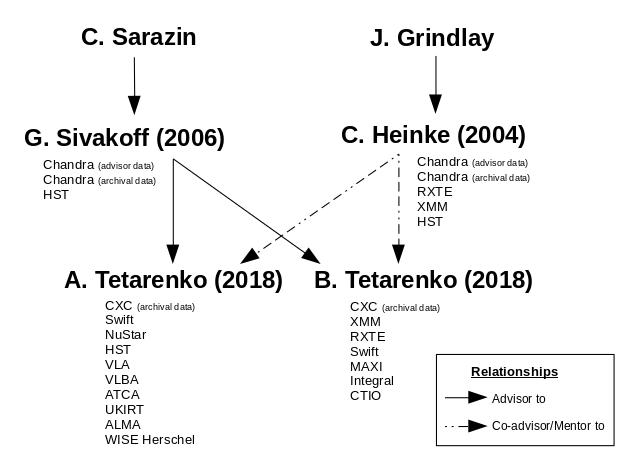Chandra Bibliography Expands Its Scope
Sherry Winkelman
The Chandra Bibliography made two important expansions in 2021: 1) we have added a Chandra Source Catalog (CSC) Bibliography, a prong to quantify science research using the CSC, and 2) we have greatly expanded our collection of dissertations that use Chandra data by tapping into the Astronomy Genealogy Project (AstroGen).
CSC Bibliography
The number of science research publications that use the CSC in the analysis has been steadily accumulating, averaging ∼16 papers a year. Now that CSC 2.0 has been available for several years, it was time to develop a more thorough description of CSC science within the Chandra Bibliography.
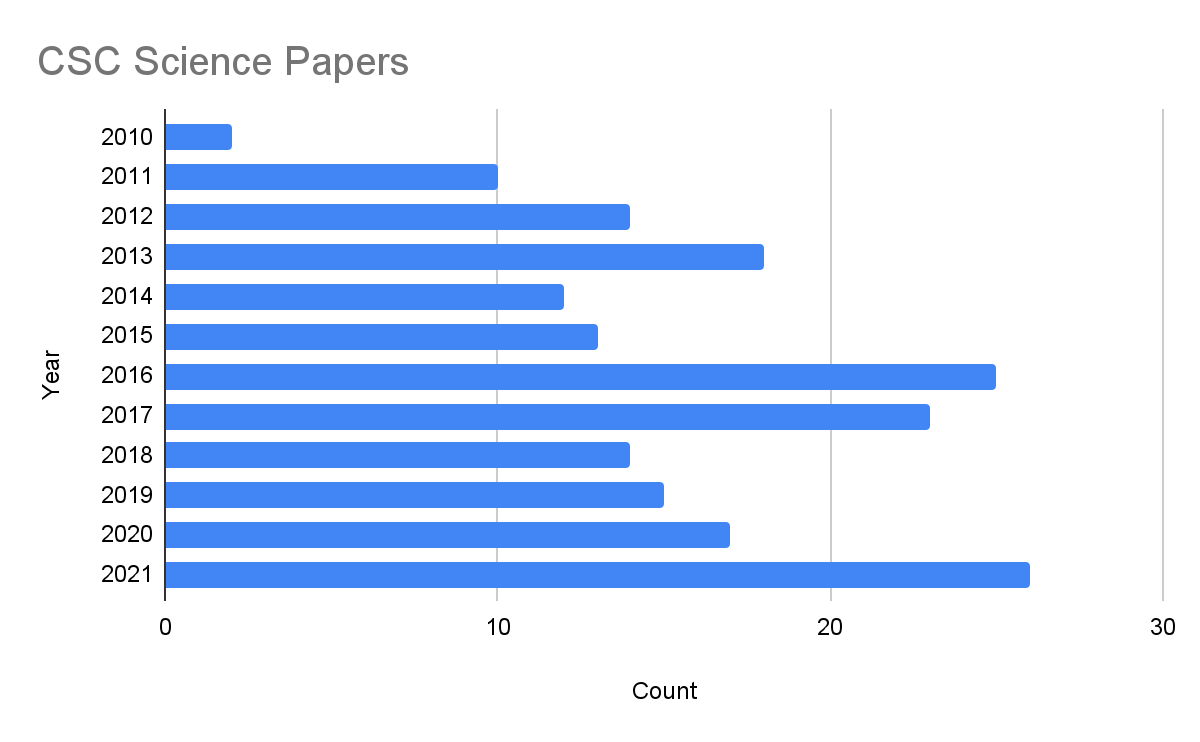
The CSC science team helped define a set of flags to quantify, among other things: the science impact of the CSC to the science in the paper; type of scientific usage; and types of CSC products used. A workflow and tools were developed to assign the defined flags to publications and incorporate the information into the Chandra Bibliography. The CSC science team stepped forward to review and classify the ∼400 papers previously identified as having a likely connection to the CSC.
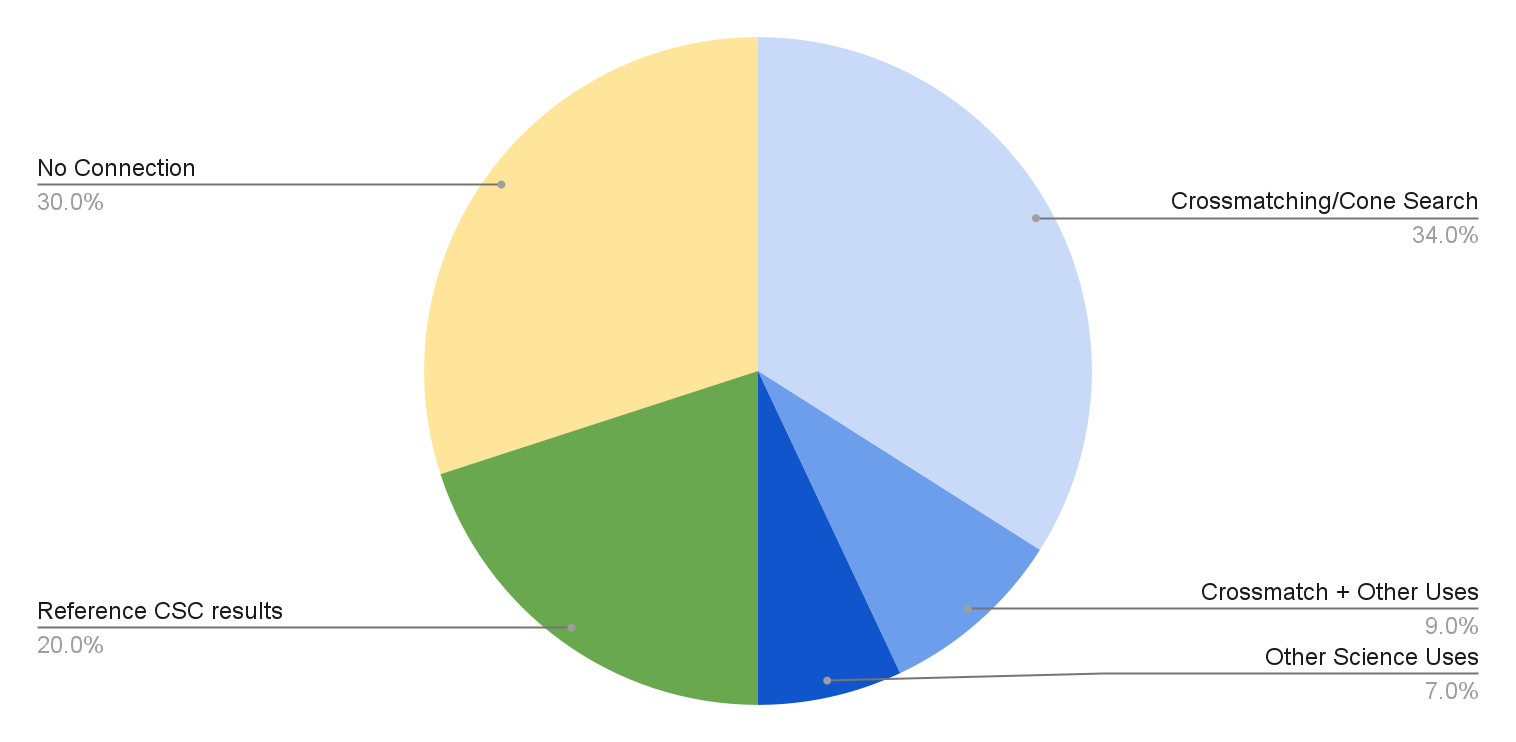
Breakdown of the relationships between the science content of an article and the contribution of the CSC to the research presented in the paper. Percentages are based on the total number of papers reviewed.
Analysis of the metadata is ongoing and the number of CSC science papers published each year is growing. Furthermore, 50% of the reviewed papers are CSC scientific papers, i.e. use of CSC and its products makes a significant contribution to scientific conclusions of the paper, and when looking at the types of scientific usage (e.g., cross-matching, population studies, excluding detections), ∼32% of the CSC science papers use CSC for something other than crossmatching or for crossmatching and something else. We also found a few mentions of the technical aspects of the CSC that illustrate the importance of the methodologies developed for this project and their relevance outside of the CSC domain (see, 2010ApJ…714.1582B, section 5.1).
Surprisingly, 30% of the papers that mention the CSC (usually in the acknowledgement section) had no discernible use of the CSC. While we are sure that Chandra users are honestly enthusiastic about everything that CXC has to offer, this is one of the cases where less is more. Incorporating any use of Chandra data, software, or the CSC into the data and methodology sections would really make our life a bit easier.
And here are a few CSC papers to wet your whistle:
- Probing the Milky Way’s Dark Matter Halo for the 3.5 keV Line Sicilian, Dominic; Cappelluti, Nico; Bulbul, Esra; Civano, Francesca; Moscetti, Massimo; Reynolds, Christopher S. (2020ApJ…905..146S)
- Cross-correlating Cosmic Infrared and X-Ray Background Fluctuations: Evidence of Significant Black Hole Populations among the CIB Sources Cappelluti, N.; Kashlinsky, A.; Arendt, R. G.; Comastri, A.; Fazio, G. G.; Finoguenov, A.; Hasinger, G.; Mather, J. C.; Miyaji, T.; Moseley, S. H. (2013ApJ…769…68C)
- The AGN Ionization Cones of NGC 5728. I. Excitation and Nuclear Structure Durré, Mark; Mould, Jeremy (2018ApJ…867..149D)
- A bright off-nuclear X-ray source: a type IIn supernova, a bright ULX or a recoiling supermassive black hole in CXOJ122518.6+144545 Jonker, P. G.; Torres, M. A. P.; Fabian, A. C.; Heida, M.; Miniutti, G.; Pooley, D. (2010MNRAS.407..645J)
- Do the Most Massive Black Holes at z = 2 Grow via Major Mergers? Mechtley, M.; Jahnke, K.; Windhorst, R. A.; Andrae, R.; Cisternas, M.; Cohen, S. H.; Hewlett, T.; Koekemoer, A. M.; Schramm, M.; Schulze, A.; Silverman, J. D.; Villforth, C.; van der Wel, A.; Wisotzki, L. (2016ApJ…830..156M)
With the backfill behind us, we will continue to populate the CSC bibliography as new papers are published and will be publishing a CSC ‘Bib Group’ to ADS, allowing researchers to filter their search results to identify CSC science cases.
Chandra Dissertations
Several years ago we started the Chandra dissertation genealogy as an interesting way to highlight the broader impacts that Chandra has within the astronomical community. Assessing the “percolation” of Chandra knowledge across academic generations is one of the few tools in our possession to visualize and measure the growth of a human scientific community (see Fig. 3). We collected advisor, granting institution, and country information for the Chandra science dissertations in the Chandra bibliography. Collecting and curating the metadata was an intense manual endeavor. Within the results, we identified the seeds for the Chandra Dissertation Genealogy, specifically, seven clear instances where the use of Chandra data in scientific studies was passed onto another generation of dissertations.
While ADS allows curators to readily identify journal articles of interest, the coverage of dissertations continues to be problematic because of the intricate and complex mix of publication policies for student dissertations across different institutions, countries and times. AstroGen, sponsored by the AAS Historical Astronomy Division and hosted online by the AAS, currently lists about 38,000 people who have either earned astronomy-related doctorates or supervised them. They provide direct links to ∼50% of the dissertations and another ∼20% are available through ProQuest. The aggregation of links to dissertations and links between advisors and students that AstroGen provides makes this an important new resource for finding observatory-related dissertations.
As a pilot study, we started with our known list of Chandra dissertations and queried AstroGen in an iterative process by: traversing down the branches of all students to look for additional Chandra dissertations in which they were advisor or mentor to, and traversing up the branches of advisors/mentors to look for additional Chandra dissertations from their other students.
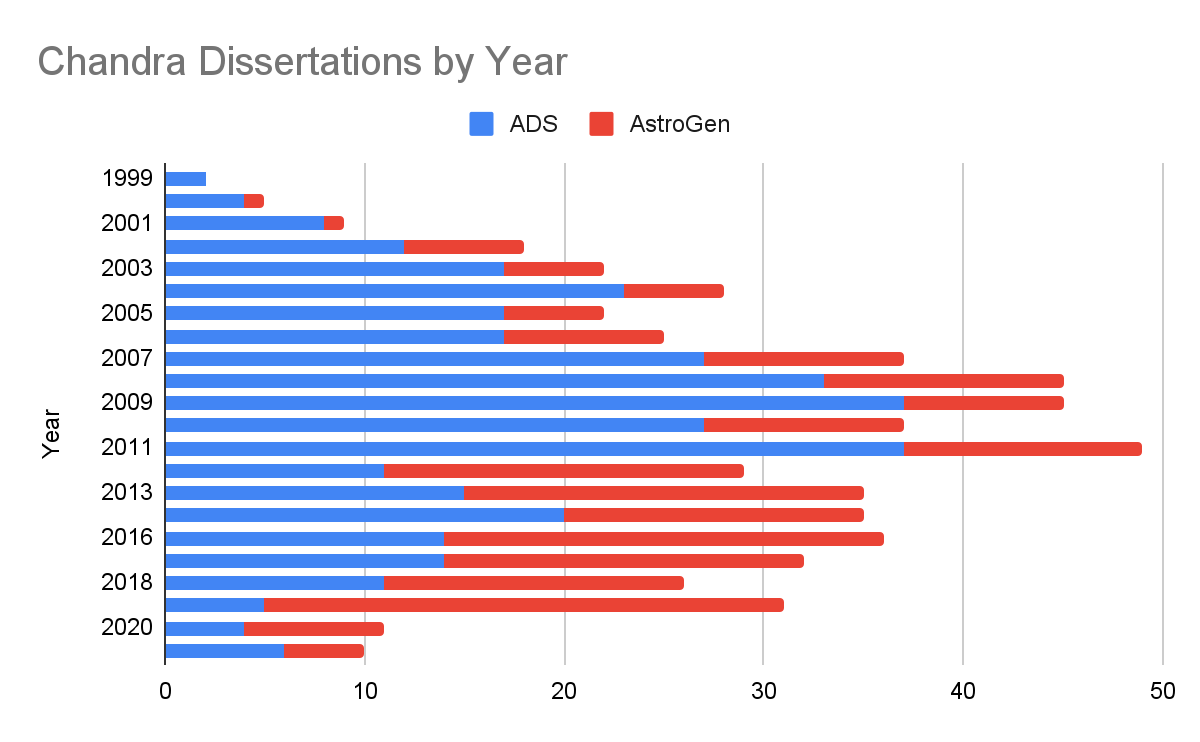
The number of dissertations where Chandra data plays a significant contribution to the scientific conclusions in the thesis. The blue bars indicate dissertations discovered through queries to ADS. The red bars indicate dissertations discovered through queries to AstroGen. A small number of the AstroGen dissertations were also in ADS but were not discovered through our queries because ADS provides limited searching of many dissertations.
The results are very promising; starting with ∼400 dissertations, we increased our collection by 59%, most of which were not in ADS. We also found 35 advisors and students who were missing from AstroGen. Even more exciting, we: 1) discovered an additional 15 Chandra dissertations where in the advisor’s dissertation was a Chandra thesis and 2) added Switzerland to the global coverage of Chandra dissertations.
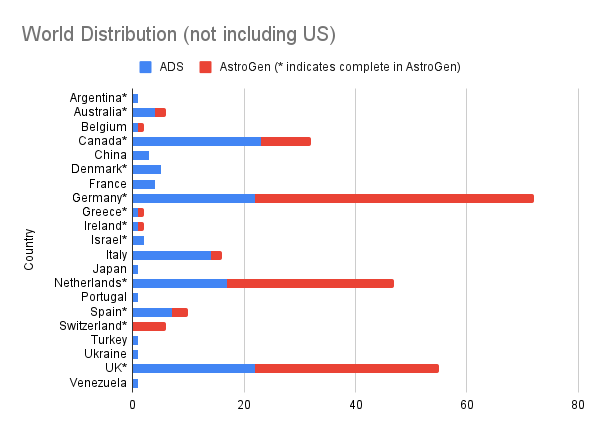
The distribution of Chandra dissertations by their country of origin. The blue bars indicate dissertations discovered through queries to ADS. The red bars indicate dissertations discovered through queries to AstroGen. A small number of the AstroGen dissertations were also in ADS but were not discovered through our queries because ADS provides limited searching of many dissertations. The counts for dissertations originating from the US are 263 (ADS) and 103 (AstroGen).
We have been working with ADS and AstroGen to include the new dissertations, advisors, and students in their collections. AstroGen has given ADS their entire ‘latest’ listing of dissertations and ADS is working to publish bibcodes for dissertations missing from their databases. With these collaborative relationships, the Chandra bibliography will be able to implement a sustainable workflow that will include searches in both ADS and AstroGen to increase the collection of Chandra dissertations and perhaps discover the third generation of Chandra dissertations.
